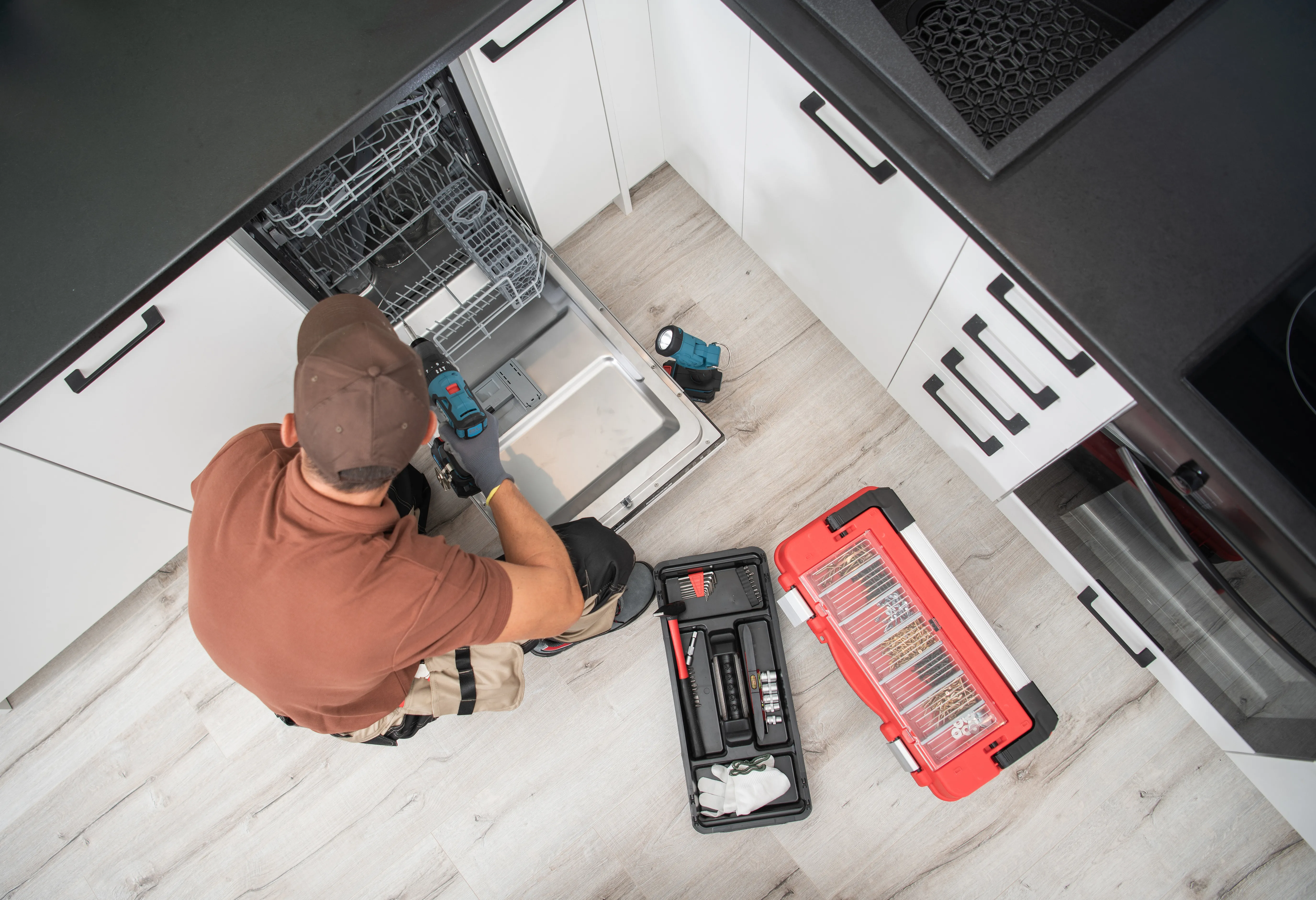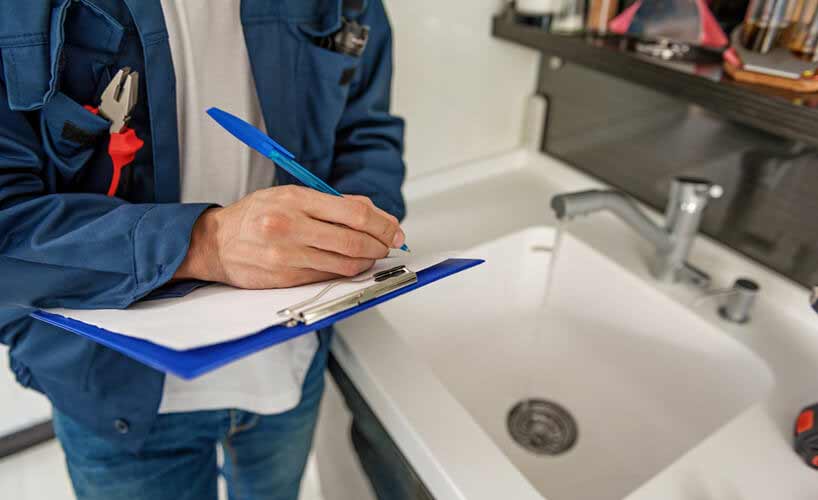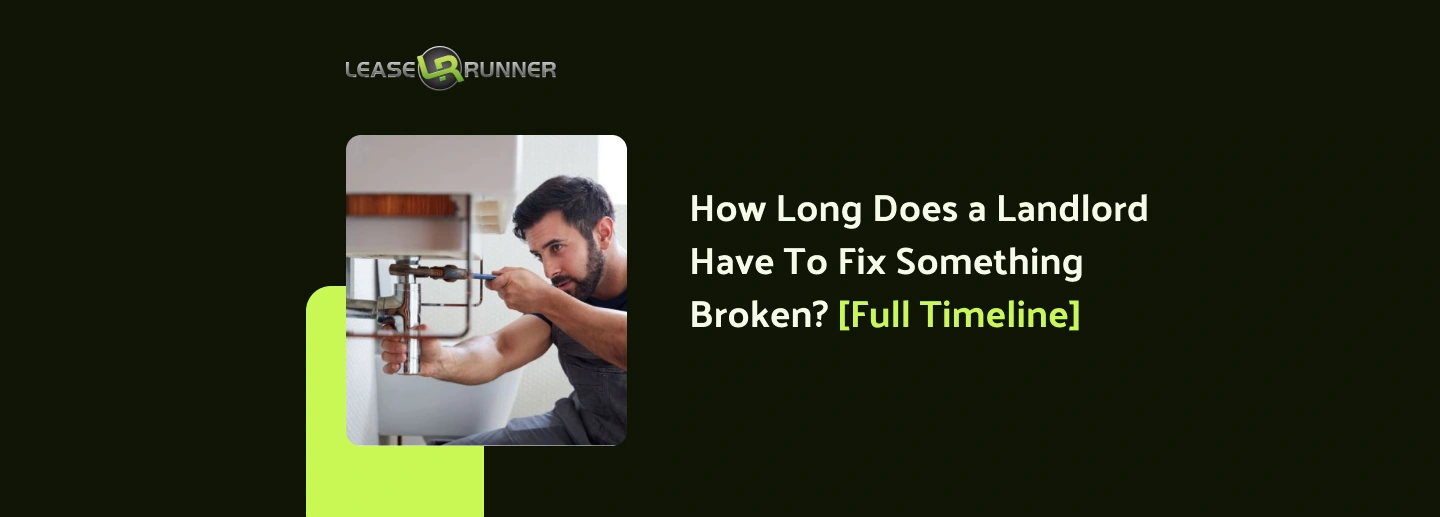How long does a landlord take to fix something is a question that all tenants and landlords will find themselves asked at one point or another. Here at LeaseRunner, we believe knowing repair timelines benefits both landlord compliance and tenant comfort.
Whether a faulty tap or broken heater, the expected response time has everyone on the same page. In this guide, we’ll break down the legal requirements, industry averages, and best practices for handling repairs.
We’ll also explore what counts as a reasonable time for a landlord to make repairs and how state laws can affect your obligations. Let’s ensure your property remains safe, habitable, and stress-free for everyone involved.

Quick Facts: Repair Timelines & Key Criteria
What Repairs Are Landlords Legally Required to Make?

Understanding what landlords' responsibilities are is highly important, especially for first-time landowners. Landlords are legally responsible for keeping rental properties in a condition that is safe and habitable.
This entails fixing things that impact tenants' health and comfort. Knowing what needs to be fixed by a landlord is crucial to staying in compliance and keeping tenants happy. By law, landlords are required to make repairs to damages that affect a property's habitability, including:
- Structural damage (roof, walls, foundation)
- Plumbing and sanitation (sinks, toilets, pipes)
- Heating and hot water heaters
- Electric wiring and electrical outlets
- Appliances included in the lease
- Insect infestations (as long as they are not due to tenant negligence)
- Broken doors, locks, and windows
These standards are based on municipal and state statutes, as well as the implicit promise of habitability. If a tenant notifies us about a problem, we’re responsible for addressing it within a reasonable time for the landlord to make repairs, especially if it impacts habitability.
Habitability Standards: Plumbing, Heat, Electricity, Pests
Becoming a landlord always goes along with multiple responsibilities. Standards of habitability provide the tenant with a safe working dwelling. Plumbing, heating, electrical, and pest control are non-negotiable when it comes to repairs.
For instance, how long does the landlord take to repair plumbing? Pipe bursts are to be repaired within 24–48 hours, while small leaks within 30 days.
In the same way, how many days the landlord takes to repair an electrical issue depends on the severity; large power outages must be corrected within 24–48 hours.
State-specific preference is an important consideration. In California, non-emergency repairs may be done within 30 days, but are required immediately in emergencies. Scheduling in Texas and New York is similar but may vary for some utilities or pests. Check local ordinances for exact requirements.
Required vs Cosmetic Repairs
Not everything needs to be repaired by law. Separating essential from cosmetic repairs allows landlords to establish clear-cut boundaries and prioritize what needs to be fixed first, and fast.
As mentioned, essential repairs impact habitability—consider heat, water, or appliances that don't work and are part of the lease. These directly affect the tenant’s health, safety, or ability to use the property as intended.
Cosmetic repairs are for fixes that don’t affect safety or basic living conditions, such as cracked paint or creaky doors. They are generally not time-sensitive and perhaps not legally mandatory. Common examples of cosmetic repairs include:
- Scratched paint or outdated flooring
- Loose doorknobs (unless security-related)
- Loud but functional HVAC units
- Mismatched tiles or cabinets
- Cosmetic cracks that don’t impact the structure
State statutes usually state what must be repaired. In Florida, for instance, landlords are required to fix electrical problems and plumbing, but not to fix minor cosmetic imperfections unless safety concerns are at stake.
Why Timely Repairs Matter: Legal, Financial, and Tenant Relations

Prompt repairs are more than just about being required by law—accuracy here is key to tenant trust, lease renewal, and our company reputation as property managers.
Noncompliance with repair requests can result in fines, lawsuits, or even mandatory rent reduction. Tenants may also be entitled to withhold rent or repair the issue themselves and deduct the cost.
Quick replies demonstrate that we care about tenant comfort and safety, strengthening trust and generating positive feedback.
At LeaseRunner, we know that prompt repair management is a two-way advantage: it maintains properties in great condition and keeps tenants satisfied, and it helps us avoid expensive and legal repercussions.
How Long Does a Landlord Have To Fix Something Broken?
It is good to know how long a landlord has to repair something, for both landlords and tenants. Field standards recommend:
- Emergency repairs: 24–72 hours (for example, no heat in the winter, serious leaks). These are issues posing immediate threats to tenant health or safety or causing significant damage to the property.
- Non-emergency repairs: 7–30 days (for example, broken appliances, small leaks). These are issues that do not pose an immediate risk to health, safety, or property, but still require attention to maintain habitability and comfort.
These schedules represent what most tenants could reasonably expect and what courts would consider "reasonable." However, the definitive answer to how long a maintenance request should take is dependent on the urgency of the issue.
Local legislation also enters the picture. For urgent repairs, timing issues could render a property unlivable, subjecting us to litigation. For non-urgent repairs, we have some leeway, but rapid resolution is still a good policy.
Key Factors Influencing Repair Timelines
There are several reasons why a landlord needs to make repairs so quickly:
- The severity of the problem: Medical or dangerous issues must be addressed urgently.
- Local and state regulations: A few states have stringent time deadlines; others have the "reasonable time" standard.
- Cooperation of tenants: We may need to enter the apartment, delays when tenants are not accessible.
- Parts or contractor availability: We have supply chain delays or labor shortages that can delay schedules.
- Weather and emergencies: Response time may be impacted by severe weather or natural disasters.
A “reasonable time" in California, for instance, is usually 30 days for non-emergency repair. We are required, by an implied warranty of habitability, to make all units safe and habitable. Reasonableness is variable: life safety matters need to be addressed immediately, while non-emergency matters have some latitude.
Typical Repair Timeframes by Type of Issue for Landlords
Let's divide the typical timelines into categories of repairs:
- Emergency Repairs (0–24 Hours): Leaks in gas, no heat during winter, significant water leaks, electrical danger. Fixing has to be done immediately.
- Essential Utilities (1–3 Days): Plumbing malfunctions, faulty toilets, no hot water, faulty refrigerators.
- Minor or Non-Essential Repairs (7–30 Days): Faulty dishwashers, cosmetic, small leak, or non-essential appliance malfunction.
For appliances, how soon does a landlord repair appliances such as microwaves or dishwashers? 7–14 days are generally typical, though emergency appliance breakdowns (such as a refrigerator) might be done more quickly.
So in summary, the typical time a landlord has to fix something depends on how urgent the repair is, the types of repairs, and many other factors involved:
How Different States Define Repair Deadlines (Quick Breakdown)?

Each state has its own policy regarding the timeline for how fast a landlord must repair. Here is a quick summary of four large states:
California
In California, landlords are required to repairs in a “reasonable time," typically 30 days for non-emergency repairs. Emergency repairs, no heat, severe leaks, or electrical issues need to be repaired right away. Not repairing can result in tenant remedies of rent withholding or repair-and-deduct.
Texas
Texas repair-related law mandates the repair of concerns relating to health and safety within 7 days of written notice. Repair of emergencies such as sewage or no water may demand more immediate action. The tenants may report to local authorities or initiate legal action in case of a delay in repairs.
New York
New York requires habitable space on the landlord's part. Emergency repairs must be done “immediately," and others that are not emergent must be done within a reasonable time, usually interpreted as 30 days. Tenants can complain to the housing authorities if there is a delay in repairs.
Florida
In Florida, 7 days is the time allowed for landlords to start making repairs upon the written notice from tenants. The response in emergency cases should be prompt. If the repairs are not made, the tenants may withhold rent or terminate the lease. Cosmetic repairs have less regulation, but should be attended to quickly for tenant satisfaction.
What Landlords Should Do When a Tenant Submits a Maintenance Request?
When a tenant submits a complaint, an efficient and clear communication procedure is crucial. The following steps outline an effective process for landlords when handling maintenance requests:
Step 1. Require written notice or portal submission
Landlords should require tenants to submit maintenance requests in writing or through an online portal. This practice ensures a clear, documented record of the issue, which helps landlords prioritize critical repairs. Written notice is mandatory by law in most states for some repairs.
Step 2. Acknowledge and respond promptly
Prompt acknowledgment reassures tenants that their requests are being handled. Landlords should aim to respond within 24 hours, even if the repair itself may take longer. This timely communication is key to maintaining tenant trust and demonstrates adherence to the "reasonable time" clause often required by law for landlords to make repairs.
Step 3. Granting access within a reasonable time
Landlords should arrange access to the property as quickly as possible once a maintenance request is received. In emergencies where immediate access may be required, landlords must inform tenants and act accordingly under the provisions of local laws regarding emergency entry.
Rescheduling access can lengthen repair time; therefore, it often requires tenant cooperation and agreement.
Step 4. Take action if the tenant refuses access
If a tenant denies entry for scheduled repairs after proper notice, landlords should record the attempt and reschedule if feasible.
Consistent refusal can impact repair timing and potentially affect tenant rights or landlord liabilities. It is advisable for landlords to consult with legal counsel to ensure compliance with state law and the lease agreement in such situations.
What Happens If You Don’t Fix the Issue On Time?
Failing to fix repairs on time can have serious consequences for landlords:
- Legal action: Tenants may withhold rent, make repairs, deduct costs, or sue for damages.
- Fines and penalties: Local authorities may impose fines for code violations.
- Lease termination: Tenants may have the right to break the lease without penalty.
- Reputation damage: Negative reviews and complaints can harm our standing as property managers.
At LeaseRunner, we prioritize timely repairs to avoid these risks and maintain positive tenant relationships. Addressing issues within a reasonable time for the landlord to make repairs is not just good practice; it’s essential for legal compliance and business success.

Should You Hire a Property Manager to Handle Repairs?
Managing repairs may be very time-consuming. Many landlords worry whether hiring a property manager is the correct decision. Consider these factors when determining how long a landlord has to mend anything and other maintenance requirements.
Pros of Hiring a Property Manager
Hiring a property manager can bring you various benefits. Here are some of them:
- Expertise: Property managers understand the legislation and how to handle repairs. If a tenant reports a burst pipe, a manager will be aware that the time limit for a landlord to repair plumbing concerns is often shorter than 24 hours. They contact a plumber straight away and retain records for legal reasons.
- Efficiency: Managers have a list of reliable providers. If a refrigerator breaks, a repair technician can come out within 1-3 days, satisfying the criteria for how long a landlord may fix household items. They also keep track of all requests in a system, ensuring that nothing is overlooked.
- Tenant Satisfaction: A property manager responds quickly to maintenance requests. If a tenant reports a broken outlet, the manager arranges for an electrician and updates the tenant. Quick action fosters confidence and aligns with maintenance request timelines.
- Legal Compliance: Managers understand the appropriate time for a landlord to perform repairs in each state. They ensure that emergencies are resolved within 24-48 hours and minor repairs within 7-30 days.
Cons of Hiring a Property Manager
Besides many pros, there are still some cons you should notice about hiring a property manager to handle repairs:
- Management costs might range from 8 to 12% of your rental revenue. This decreases your profits.
- Less Control: You will not be engaged in all repair decisions. Some landlords prefer to choose their own suppliers and do repairs themselves.
- Quality varies: Not all managers provide the same service. Some tenants may be sluggish or ignore details, leading to longer maintenance timelines for landlords.
Before hiring, evaluate prices and services. Inquire about response times, vendor lists, and the way they handle emergency repairs.
Best Practices for Landlords to Make Fast, Compliant Maintenance

To ensure that a landlord has a reasonable amount of time to fix something that is always up to code, we use proven techniques for fast, reliable repairs. Here's how we ensure that our properties are safe and tenants are content:
- Regularly Checks
We schedule checks on electrical and plumbing systems every several months. For example, we inspect for leakages or damaged wires before tenants notice them. This enables us to fix problems early before they become emergencies.
- Transparency of Communication
Tenants ensure repair requests are done in writing via email or a portal such as LeaseRunner. We get back within 24 hours. If a tenant has reported a faulty heater, for example, we acknowledge it on the same day and arrange for a repair date and time. It guarantees that how long a maintenance request should take is always transparent.
- Put Emergency Repairs First
Leaks of gas, no heat in winter, or ruptured pipes are repaired within 24 hours. If a pipe breaks at night, we immediately contact our plumber and alert the tenant until the repair is completed. This is the norm for how long a landlord should repair plumbing problems and how long a landlord should repair an electrical issue.
- Document Everything
We document all requests, responses, and repairs. That is, invoices, photos, and emails. For instance, after they have repaired a refrigerator, we retain the repair invoice and photo of a working appliance. This comes in handy in case there is a question on when a landlord should take time to repair appliances or what was repaired.
- Be Current with Laws
We analyze state and local laws constantly. For instance, in California, we are aware that non-emergency repairs should be accomplished within 30 days, but emergencies should be addressed immediately. This enables us to always have a time period when we can make the repairs affordable to the landlord.
- Utilize Good Vendors
We have good vendors who respond in time. For instance, our go-to electrician handles emergency calls within hours, which allows us to respond in time.
By doing so, we maintain repairs on time, legal, and documented, safeguarding both tenants and our property.
Bottom Line
The time a landlord has to fix something will vary depending on the severity of the issue, state laws, and tenant cooperation. We strive to complete all repairs—emergency, significant, or minor—within trade standards to provide tenant safety and satisfaction at LeaseRunner.
Emergencies should be addressed within 24 hours, necessary repairs within 1-3 days, and the remaining in 7-30 days. Knowing our role, communicating efficiently, and pro-anticipating maintenance saves us, our properties, our tenants, and our reputation.
For more information about best practices in property management, read LeaseRunner blog and learn more about our landlord and tenant resources.
FAQs
Q1. How long does a landlord have to make repairs after a tenant's request?
For emergencies—like a burst pipe, no heat in winter, or an electrical outage—a landlord should start repairs within 24 to 48 hours. For non-urgent repairs, such as a leaky faucet or broken cabinet, the timeline is usually 7 to 30 days.
The exact time depends on state law and how serious the problem is. Always report urgent issues right away and follow up if you don't get a prompt response.
Q2. What does a landlord have to fix by law?
Landlords must fix anything that affects health, safety, or habitability. This includes plumbing leaks, broken heaters, faulty wiring, pest infestations, and any appliances listed in your lease.
For example, if your refrigerator stops working and it was included in your rental agreement, the landlord must repair or replace it. If the issue is cosmetic—like chipped paint—they may not be required to fix it unless local laws say otherwise.
Q3. How long does a landlord have to fix appliances?
If the appliance is essential (like a refrigerator or stove), repairs should be made within 1 to 3 days. For non-essential appliances (such as a dishwasher or microwave), landlords might have up to 14 days.
If the appliance is not listed in your lease, the landlord may not have to repair it. Always check your lease and local laws for details.
Q4. What is considered a reasonable time for a landlord to make repairs?
A “reasonable time for the landlord to make repairs” is based on the urgency of the problem and state rules. For urgent issues—like no heat, flooding, or electrical hazards—reasonable means 24 to 72 hours. For less urgent problems, reasonable can mean up to 30 days.
If repairs take longer, tenants may have the right to withhold rent or make the repair themselves and deduct the cost.
Q5. How long should a maintenance request take to be resolved?
A maintenance request should be acknowledged within 24 hours. For emergencies, repairs should be started the same day. For non-urgent requests, expect the issue to be fixed within 7 to 30 days.
If you don't get a reply, send a written reminder and keep records. If the landlord still does not act, you may contact local housing authorities or seek legal advice.
Q6. What can tenants do if repairs are not made on time?
Tenants can send a written reminder, document the problem, and check local laws for next steps. In many places, tenants can withhold rent, pay for repairs, and deduct the cost, or report the issue to city inspectors. If the problem is severe, tenants may be able to break the lease without penalty.
Q7. Does a landlord have to fix cosmetic issues?
Usually, landlords are not required to fix cosmetic issues like small holes in the wall, faded paint, or worn carpet. However, if the cosmetic issue affects safety or health—such as mold from water damage—they must address it. Always check your lease and local regulations for specific rules.







